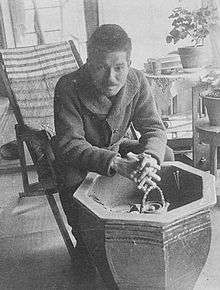Tomimoto Kenkichi
Tomimoto Kenkichi (富本憲吉, June 5, 1886 – June 8, 1963) was a Japanese potter and a Living National Treasure.

Biography
His family came from Nara prefecture.
He received a commission to design a large Japanese-lacquered zelkova shelf called “kingin-sai kazari tsubo” for the Ume-no-Ma audience room of Tokyo Imperial Palace.[1]
In November 1914, Tomimoto married Otake Kazue (also known as 'Kokichi'), a niece of the artist Otake Chikuha. Kazue was at one time a member of the feminist literary group Seito (publishers of the magazine of the same name, Bluestocking). A controversial figure in her youth, Kazue had a close relationship (and, it was thought, an infatuation) with Raicho Hiratsuka. It is thought that Tomimoto may have drawn an early draft of the woodblock print which Otake finished and submitted to Seito, which appeared as the cover of the 1913 New Year's issue of Seito magazine.[2]
After marrying, the couple moved to Nara, Japan. Tomimoto and Kazue had three children together, but later separated.[3]
Honors
He was a recipient of the Order of Culture. He was also named a Living National Treasure.
The Tomimoto Kenkichi Memorial Museum was opened in 1974 in Ando, Nara.
References
- "The Imperial Palace: Photo - The Imperial Household Agency". www.kunaicho.go.jp. Retrieved 2019-07-21.
- Raicho Hiratsuka (trans. Teruko Craig), In the Beginning, Woman Was the Sun – The Autobiography of a Japanese Feminist(『元始、女性は太陽であった』, Genshi, josei wa taiyō de atta),pp.186, 205
- Raicho Hiratsuka (trans. Teruko Craig), In the Beginning, Woman Was the Sun – The Autobiography of a Japanese Feminist(『元始、女性は太陽であった』, Genshi, josei wa taiyō de atta),pp.217, 324